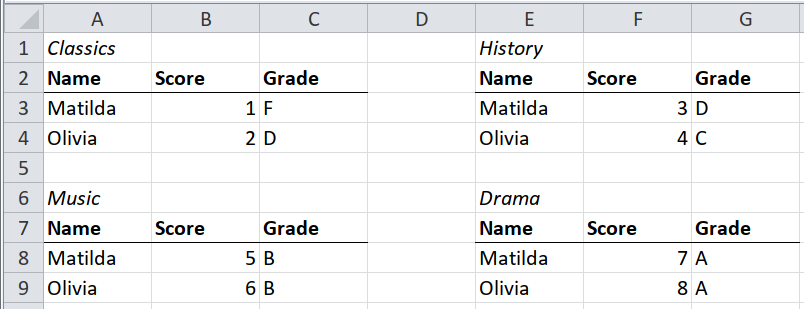4.1 Small multiples with all headers present for each multiple

The code to import one of these multiples will be simple.
cells %>%
behead("up-left", subject) %>%
behead("up", header) %>%
select(-col, -local_format_id) %>%
spatter(header) %>%
select(-row)The first table is in rows 1 to 4, columns 1 to 3, so we start by writing the code to import only that table.
path <- system.file("extdata", "worked-examples.xlsx", package = "unpivotr")
all_cells <-
xlsx_cells(path, sheets = "small-multiples") %>%
dplyr::filter(!is_blank) %>%
select(row, col, data_type, character, numeric, local_format_id)
table1 <- dplyr::filter(all_cells, row %in% 1:4, col %in% 1:3)
table1 %>%
behead("up-left", subject) %>%
behead("up", header) %>%
select(-col, -local_format_id) %>%
spatter(header) %>%
select(-row)## # A tibble: 2 x 4
## subject Grade Name Score
## <chr> <chr> <chr> <dbl>
## 1 Classics F Matilda 1
## 2 Classics D Olivia 2We wrap that code in a function, to be applied to each separate table.
unpivot <- function(cells) {
cells %>%
behead("up-left", subject) %>%
behead("up", header) %>%
select(-col, -local_format_id) %>%
spatter(header) %>%
select(-row)
}Now we partition the spreadsheet into the separate tables. This is done by identifying a corner cell in each table.
formats <- xlsx_formats(path)
italic <- which(formats$local$font$italic)
corners <-
all_cells %>%
dplyr::filter(local_format_id %in% italic) %>%
select(row, col)
partitions <- partition(all_cells, corners)
partitions## # A tibble: 4 x 3
## corner_row corner_col cells
## <dbl> <dbl> <list>
## 1 1 1 <tibble [10 × 6]>
## 2 1 5 <tibble [10 × 6]>
## 3 6 1 <tibble [10 × 6]>
## 4 6 5 <tibble [10 × 6]>Finally, map the unpivoting function over the partitions, and combine the results.
partitions %>%
mutate(cells = map(cells, unpivot)) %>%
unnest() %>%
select(-corner_row, -corner_col)## Warning: `cols` is now required.
## Please use `cols = c(cells)`## # A tibble: 8 x 4
## subject Grade Name Score
## <chr> <chr> <chr> <dbl>
## 1 Classics F Matilda 1
## 2 Classics D Olivia 2
## 3 History D Matilda 3
## 4 History C Olivia 4
## 5 Music B Matilda 5
## 6 Music B Olivia 6
## 7 Drama A Matilda 7
## 8 Drama A Olivia 8